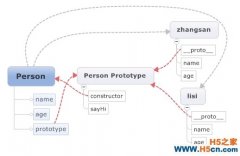function Parent(username){
this.username = username;
this.say = function(){
alert(this.username);
}
}
function Child(username,password){
this.temp = Parent;//temp指向Parent所指向的地方 。 利用js里的每一个方法名都是一个Function对象,指向一个方法。
this.temp(username);//初始化方法里的内容
delete this.temp;//temp没有用了。可以直接删除掉.this不可以丢了
//Parent(username);//这样写表面看起来是正确的,其实是错误的。因为只有new出来的对象才有this,所以调用Parent里的this就没有值了
this.password = password;
this.hello = function(){
alert(this.password);
}
}
var parent = new Parent("zhangsan");
parent.say();//zhangsan
var child = new Child("lisi","123456");
child.say();//lisi
child.hello();//123456
//第一种方式,冒充对象的方式.(利用js里的每一个方法名都是一个Function对象)
function Parent(username){
this.username = username;
this.say = function(){
alert(this.username);
}
}
function Child(username,password){
this.temp = Parent;//temp指向Parent所指向的地方 。 利用js里的每一个方法名都是一个Function对象,指向一个方法。
this.temp(username);//初始化方法里的内容
delete this.temp;//temp没有用了。可以直接删除掉.this不可以丢了
//Parent(username);//这样写表面看起来是正确的,其实是错误的。因为只有new出来的对象才有this,所以调用Parent里的this就没有值了
this.password = password;
this.hello = function(){
alert(this.password);
}
}
var parent = new Parent("zhangsan");
parent.say();//zhangsan
var child = new Child("lisi","123456");
child.say();//lisi
child.hello();//123456
2.第二种方式:call()函数方式 call()函数是Function对象的一个函数
具体用法如下 Java代码
//call()函数是Function对象的一个函数
//具体用法如
function test(str){
alert(this.username + "," + str);
}
var o = new Object();
o.username = "zhangsan";
test.call(o,"123456");//zhangsan,123456 .因为每个Function 对象都有一个call()方法,而函数名就是一个Function对象.call()函数的第一个参数是test函数里的this.
//call()函数是Function对象的一个函数
//具体用法如
function test(str){
alert(this.username + "," + str);
}
var o = new Object();
o.username = "zhangsan";
test.call(o,"123456");//zhangsan,123456 .因为每个Function 对象都有一个call()方法,而函数名就是一个Function对象.call()函数的第一个参数是test函数里的this.
Java代码
function Parent(username){
this.username = username;
this.say = function(){
alert(this.username);
}
}
function Child(username,password){
Parent.call(this,username);
this.password = password;
this.hello = function(){
alert(this.password);
}
}
var parent = new Parent("zhangsan");
parent.say();//zhangsan
var child = new Child("lisi","123456");
child.say();//lisi
child.hello();//123456
function Parent(username){
this.username = username;
this.say = function(){
alert(this.username);
}
}
function Child(username,password){
Parent.call(this,username);
this.password = password;
this.hello = function(){
alert(this.password);
}
}
var parent = new Parent("zhangsan");
parent.say();//zhangsan
var child = new Child("lisi","123456");
child.say();//lisi
child.hello();//123456
3.第三种实现方式:apply()函数方式
apply()和call()是一样的,只不过参数传递不同而已,apply的参数为数组 Java代码
//第三种实现方式:apply()函数方式,apply()和call()是一样的,只不过参数传递不同而已,apply的参数为数组
//所以继承可以这样实现
function Parent(username){
this.username = username;
this.say = function(){
alert(this.username);
}
}
function Child(username,password){
Parent.apply(this,new Array(username));
this.password = password;
this.hello = function(){
alert(this.password);
}
}
var parent = new Parent("zhangsan");
parent.say();//zhangsan
var child = new Child("lisi","123456");
child.say();//lisi
child.hello();//123456
 相关文章
相关文章

 精彩导读
精彩导读 热门资讯
热门资讯 关注我们
关注我们
